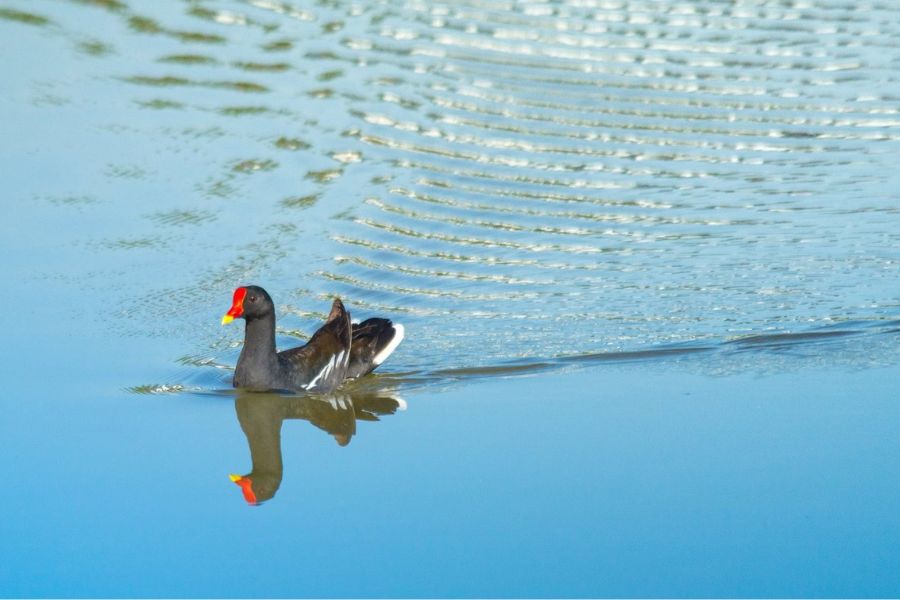Egads! You startled me!
A Eurasian Moorhen is a little flustered
SPLASH! Oh dear, did you see that? That was me, making a less-than-graceful escape. Running across water, flapping wildly before liftoff… totally intentional. Why escape? Well, you startled me… sneaking up on me with your camera, like some stealthy Croc! Graceful takeoffs are not my style. Instead, I run on water, flapping frantically before finally lifting off. No luck? Plan B: I sink into the water, leaving just my head above—stealth mode activated! So next time you spot a clumsy bird dashing across a pond, flapping like a maniac— you know who it is! By the way, despite my name, I’m not a hen. I belong to the Rail family. Closer to coots and Crakes than Chickens. My long, unwebbed toes are great for walking on floating plants and grip muddy banks like a pro. Who needs duck feet when you have these?

Story of the Photo
Yala National Park is rich in birdlife, and the Eurasian Moorhen is among its remarkable residents. Whilst staying at the Mahoora Tented Safari Camp in Yala, Dilum captured this beautiful shot of a Moorhen gracefully going about its business during his morning safari… just before it saw him and did its trademark comical takeoff!
Fun Facts
I seem chill, but come breeding season, I turn into a feathered warrior. Us Males kick-fight mid-air to claim territory. Once I win, my mate and I build a nest and raise our chicks. Raising them is a little easier because our kids from the last brood often stay back and babysit their new siblings. By the way, you’ve probably noticed my red facial shield. It isn’t just for show, you know. It signals health and dominance. A bright shield? I’m thriving. A dull one? Maybe I should eat more greens. Speaking of food, I am getting a bit “peckish”... haha, a little bird humour! I’m not picky though. Plants, insects, fish, and even carrion are all on the menu. Pristine wilderness like Yala is great to live in, but as I said before, I’m not picky. So you’ll also find me hanging out on urban ponds, canals, and reservoirs too—as long as there are some reeds to hide in.
Eurasian Moorhen Sighting at Yala National Park
Yala National Park in Sri Lanka is not only famous for its big cats but also for its surprising avian treasures. Recently, a rare Eurasian Moorhen was spotted, offering birdwatchers and wildlife enthusiasts an unexpected and memorable experience.
A Rare Bird Encounter in Sri Lanka
The Eurasian Moorhen is an uncommon visitor to Yala. This elusive bird, known for its distinctive calls and striking appearance, rarely makes an appearance in the park’s wetlands. Its presence has sparked excitement among local birdwatchers and photographers alike, eager to capture this unique moment on film.
Why the Eurasian Moorhen Matters
The sighting underscores Yala National Park’s rich biodiversity, highlighting the coexistence of both iconic mammals and lesser-known avian species.
Exploring Yala National Park: More Than Just Big Cats
While Yala is renowned for its leopard populations, it also offers abundant opportunities for wildlife photography and birdwatching. The park’s open landscapes, seasonal wetlands, and varied terrain create an ideal setting for spotting a wide range of species.
- Visit during early mornings or late afternoons when birds are most active.
- Bring a good pair of binoculars and a camera with a telephoto lens.
- Join a guided tour to gain insights from local experts who know the park’s secret birding spots.
Conservation and Sustainable Tourism
Yala National Park is a prime example of how wildlife conservation and tourism can go hand in hand. Eco tourism initiatives, including responsible wildlife viewing and community engagement, help ensure that natural habitats remain protected.
- Stick to designated paths to minimize disturbance.
- Respect the natural environment by avoiding loud noises.
- Support eco-friendly tour operators who prioritize conservation.
Plan Your Visit to Yala National Park
For those eager to experience the magic of Yala firsthand, planning your trip with expert guidance is key. Many safari camps and tour operators offer packages that focus on both the park’s big cats and its hidden avian gems.
Consider staying at well-reviewed safari camps like Mahoora Tented Safari Camp, known for its immersive wildlife experiences and commitment to sustainable tourism.
Mahoora tented safari camps Sri Lanka.

Important Links
Resort Locations
Mahoora Tented Safari Camps,
20/63,
Fairfield Garden,
Colombo 08,
Sri Lanka
(10800)
Booking & Query
P. +94 (0)702228222
Partner Properties
